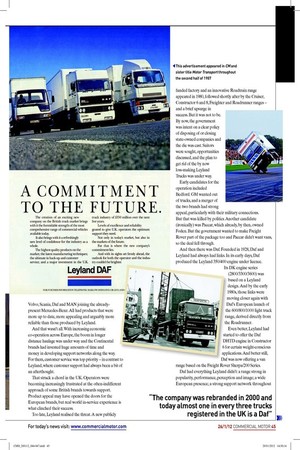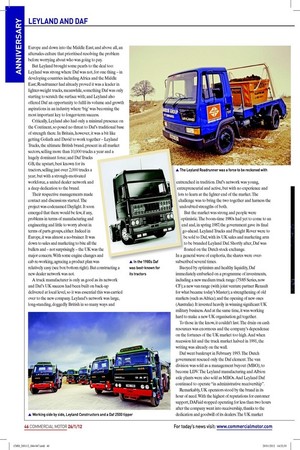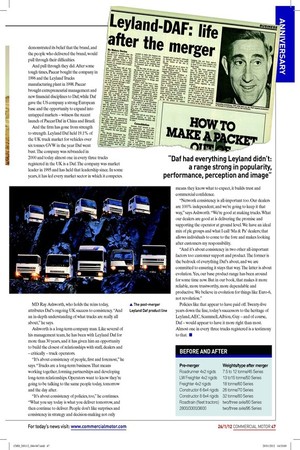THE LEYLAND DAF MERGER
Page 36

Page 37

Page 38

Page 39

If you've noticed an error in this article please click here to report it so we can fix it.
Market leader since 1995 proves marriage works
Daf’s long
oo
This month marks the 25th anniversary of the marriage between Leyland and Daf. But how did it come about? Has it been roses all the way? And 25 years down the line, is the marriage still a strong one? CM looks back...
Words: Peter Symons Being part of the Leyland/Daf merger was a bit like inding out your father is about to get together with a new partner – one with a less-than-great reputation whose children you don’t particularly like (even if you would love to play with their toys). Of course, it was the 1980s – the era of Dallas, Dynasty and huge social upheaval. More signiicantly, perhaps, it was the era of Margaret Thatcher, the Iron Lady, who was determined to face up to so many of the country’s long-running industrial sores, and – one way or another – get them sorted.
One of those sores was British Leyland. The name had become synonymous with strikes, industrial unrest, poor products and a trade union convenor and shop steward known as Red Robbo. In some circles, it had become a national joke. And certainly, it was beset with poor reliability and product quality at every level... every level, that is, except one.
The exception was Leyland Motors, which had been building trucks since 1896. At one time, it had become the largest truck manufacturer in the world, taking over brands such as AEC, Albion and Scammell. It even took over Rover before merging with British Motor Holdings and its portfolio of brands – Guy, BMC, Austin and Morris – to form British Leyland Motor Corporation (BLMC) in 1968.
Hardly surprising, BLMC proved impossible to manage. After getting into inancial dificulties, it was nationalised as British Leyland in 1975, with Leyland Truck & Bus becoming one of its four divisions. Ironically, it was the one division that continued to make a proit. Despite weaknesses in the LJK economy, trucks were still in demand and, as the premier British brand, Leyland led the market.
That was the good news. The bad news was that instead of proit being invested into new technology and products, it was stripped away to support the ailing BL car division.
It couldn’t have happened at a worse time: Britain’s 1973 membership of the EEC had smoothed the way for market entry by continental European brands such as Volvo, Scania, Daf and MAN joining the alreadypresent Mercedes-Benz. All had products that were more up to date, more appealing and arguably more reliable than those produced by Leyland.
And that wasn’t all. With increasing economic co-operation across Europe, the boom in longer distance haulage was under way and the Continental brands had invested huge amounts of time and money in developing support networks along the way. For them, customer service was top priority – in contrast to Leyland, where customer support had always been a bit of an afterthought.
That struck a chord in the LTK. Operators were becoming increasingly frustrated at the often-indifferent approach of some British brands towards support. Product appeal may have opened the doors for the European brands, but real world in-service experience is what clinched their success.
Too late, Leyland realised the threat. A new publicly
This advertisement appeared in CM and sister title Motor Transport throughout the second half of 1987
funded factory and an innovative Roadtrain range appeared in 1980, followed shortly after by the Cruiser, Constructor 6 and 8, Freighter and Roadrunner ranges – and a brief upsurge in success. But it was not to be.
By now, the government was intent on a clear policy of disposing of or closing state-owned companies and the die was cast. Suitors were sought, opportunities discussed, and the plan to get rid of the by now loss-making Leyland Trucks was under way.
Early candidates for the operation included Bedford. GM wanted out of trucks, and a merger of the two brands had strong appeal, particularly with their military connections.
But that was killed by politics. Another candidate (ironically) was Paccar, which already, by then, owned Foden. But the government wanted to make Freight Rover part of the package too and Paccar didn’t want vans, so the deal fell through.
And then there was Daf. Founded in 1928, Daf and Leyland had always had links. In its early days, Daf produced the Leyland 350/400 engine under licence.
Its DK engine series (2800/3300/3600) was based on a Leyland design. And by the early 1980s, those links were moving closer again with Daf’s European launch of the 600/800/1000 light truck range, derived directly from the Roadrunner.
Even better, Leyland had started to offer the Daf DHTD engine in Constructor 6 for certain weight-conscious applications. And better still, Daf was now offering a van range based on the Freight Rover Sherpa/200 Series. Daf had everything Leyland didn’t: a range strong in popularity, performance, perception and image; a wide European presence; a strong support network throughout Europe and down into the Middle East; and above all, an aftersales culture that prioritised resolving the problem before worrying about who was going to pay.
But Leyland brought some pearls to the deal too: Leyland was strong where Daf was not, for one thing – in developing countries including Africa and the Middle East; Roadrunner had already proved it was a leader in lighter-weight trucks, meanwhile, something Daf was only starting to scratch the surface with; and Leyland also offered Daf an opportunity to fulil its volume and growth aspirations in an industry where ‘big’ was becoming the most important key to longer-term success.
Critically, Leyland also had only a minimal presence on the Continent, so posed no threat to Daf’s traditional base of strength there. In Britain, however, it was a bit like getting Goliath and David to work together – Leyland Trucks, the ultimate British brand, present in all market sectors, selling more than 10,000 trucks a year and a hugely dominant force; and Daf Trucks GB, the upstart, best known for its tractors, selling just over 2,000 trucks a year, but with a strongly-motivated workforce, a united dealer network and a deep dedication to the brand.
Their respective managements made contact and discussions started. The project was codenamed Daylight. It soon emerged that there would be few, if any, problems in terms of manufacturing and engineering and little to worry about in terms of parts groups, either. Indeed in Europe, it was almost a no-brainer. It was down to sales and marketing to bite all the bullets and – not surprisingly – the UK was the major concern. With some engine changes and cab re-working, agreeing a product plan was relatively easy (see box bottom right). But constructing a new dealer network was not.
A truck manufacturer is only as good as its network and Daf’s UK success had been built on back-up delivered at local level, so it was essential this was carried over to the new company. Leyland’s network was large, long-standing, doggedly British in so many ways and entrenched in tradition. Daf’s network was young, entrepreneurial and active, but with no experience and lots to learn at the lighter end of the market. The challenge was to bring the two together and harness the undoubted strengths of both.
But the market was strong and people were optimistic. The boom-time 1980s had yet to come to an end and, in spring 1987, the government gave its inal go-ahead. Leyland Trucks and Freight Rover were to be sold to Daf, with its UK sales and marketing arm to be branded Leyland Daf. Shortly after, Daf was loated on the Dutch stock exchange.
In a general wave of euphoria, the shares were oversubscribed several times.
Buoyed by optimism and healthy liquidity, Daf immediately embarked on a programme of investments, including a new medium truck range (75/85 Series, now CF); a new van range (with joint venture partner Renault for what became today’s Master); a strengthening of old markets (such as Africa); and the opening of new ones (Australia). It invested heavily in winning signiicant UK military business. And at the same time, it was working hard to make a new UK organisation gel together.
To those in the know, it couldn’t last. The drain on cash resources was enormous and the company’s dependence on the fortunes of the UK market too high. And when recession hit and the truck market halved in 1991, the writing was already on the wall.
Daf went bankrupt in February 1993. The Dutch government rescued only the Daf element. The van division was sold as a management buyout (MBO), to become LDV. The Leyland manufacturing and Albion axle plants were also sold as MBOs. And Leyland Daf continued to operate “in administrative receivership”.
Remarkably, UK operators stood by the brand in its hour of need. With the highest of reputations for customer support, DAFaid stopped operating for less than two hours after the company went into receivership, thanks to the dedication and goodwill of its dealers. The UK market demonstrated its belief that the brand, and the people who delivered the brand, would pull through their dificulties.
And pull through they did. After some tough times, Paccar bought the company in 1996 and the Leyland Trucks manufacturing plant in 1998. Paccar brought entrepreneurial management and new inancial disciplines to Daf; while Daf gave the US company a strong European base and the opportunity to expand into untapped markets – witness the recent launch of Paccar/Daf in China and Brazil.
And the irm has gone from strength to strength. Leyland Daf held 19.1% of the UK truck market for vehicles over six tonnes GVW in the year Daf went bust. The company was rebranded in 2000 and today almost one in every three trucks registered in the UK is a Daf. The company was market leader in 1995 and has held that leadership since. In some years, it has led every market sector in which it competes.
MD Ray Ashworth, who holds the reins today, attributes Daf’s ongoing UK success to consistency. “And an in-depth understanding of what trucks are really all about,” he says.
Ashworth is a long-term company man. Like several of his management team, he has been with Leyland Daf for more than 30 years, and it has given him an opportunity to build the closest of relationships with staff, dealers and – critically – truck operators.
“It’s about consistency of people, irst and foremost,” he says. “Trucks are a long-term business. That means working together, forming partnerships and developing long-term relationships. Operators want to know they’re going to be talking to the same people today, tomorrow and the day after.
“It’s about consistency of policies, too,” he continues. “What you say today is what you deliver tomorrow, and then continue to deliver. People don’t like surprises and consistency in strategy and decision-making not only means they know what to expect, it builds trust and commercial conidence.
“Network consistency is all-important too. Our dealers are 100% independent, and we’re going to keep it that way,” says Ashworth. “We’re good at making trucks. What our dealers are good at is delivering the promise and supporting the operator at ground level. We have an ideal mix of plc groups and what I call ‘Ma & Pa’ dealers; that allows individuals to come to the fore and makes looking after customers my responsibility.
“And it’s about consistency in two other all-important factors too: customer support and product. The former is the bedrock of everything Daf’s about, and we are committed to ensuring it stays that way. The latter is about evolution. Yes, our base product range has been around for some time now. But in our book, that makes it more reliable, more trustworthy, more dependable and productive. We believe in evolution for things like Euro-6, not revolution.” Policies like that appear to have paid off. Twenty-ive years down the line, today’s successors to the heritage of Leyland, AEC, Scammell, Albion, Guy – and of course, Daf – would appear to have it more right than most. Almost one in every three trucks registered is a testimony to that. ■
BEFORE AND AFTER
Pre-merger Weights/type after merger Roadrunner 4x2 rigids 7.5 to 12 tonne/45 Series LW Freighter 4x2 rigids 13 to15 tonne/50 Series Freighter 4x2 rigids 18 tonne/60 Series Constructor 6 6x4 rigids 26 tonne/70 Series Constructor 8 8x4 rigids 32 tonne/80 Series Roadtrain (fleet tractors) two/three axle/80 Series 2800/3300/3600 two/three axle/95 Series











































